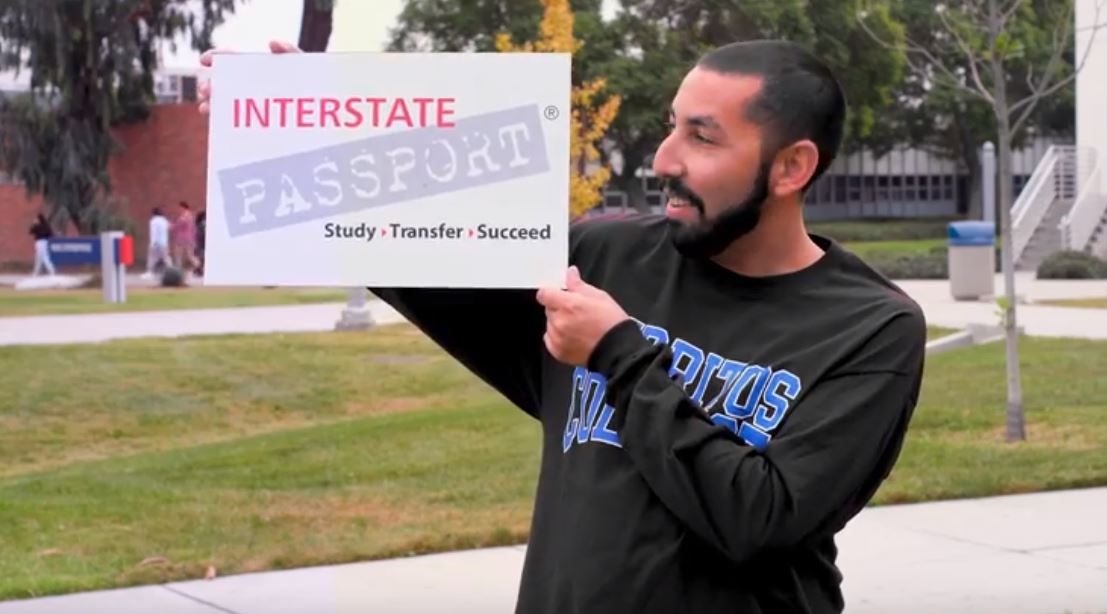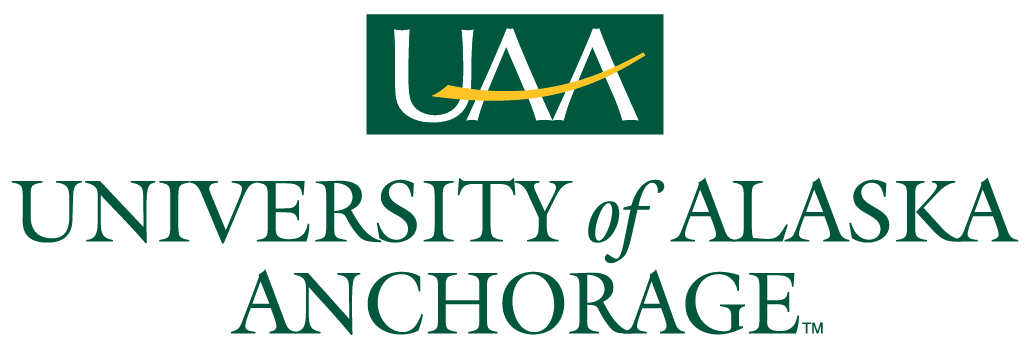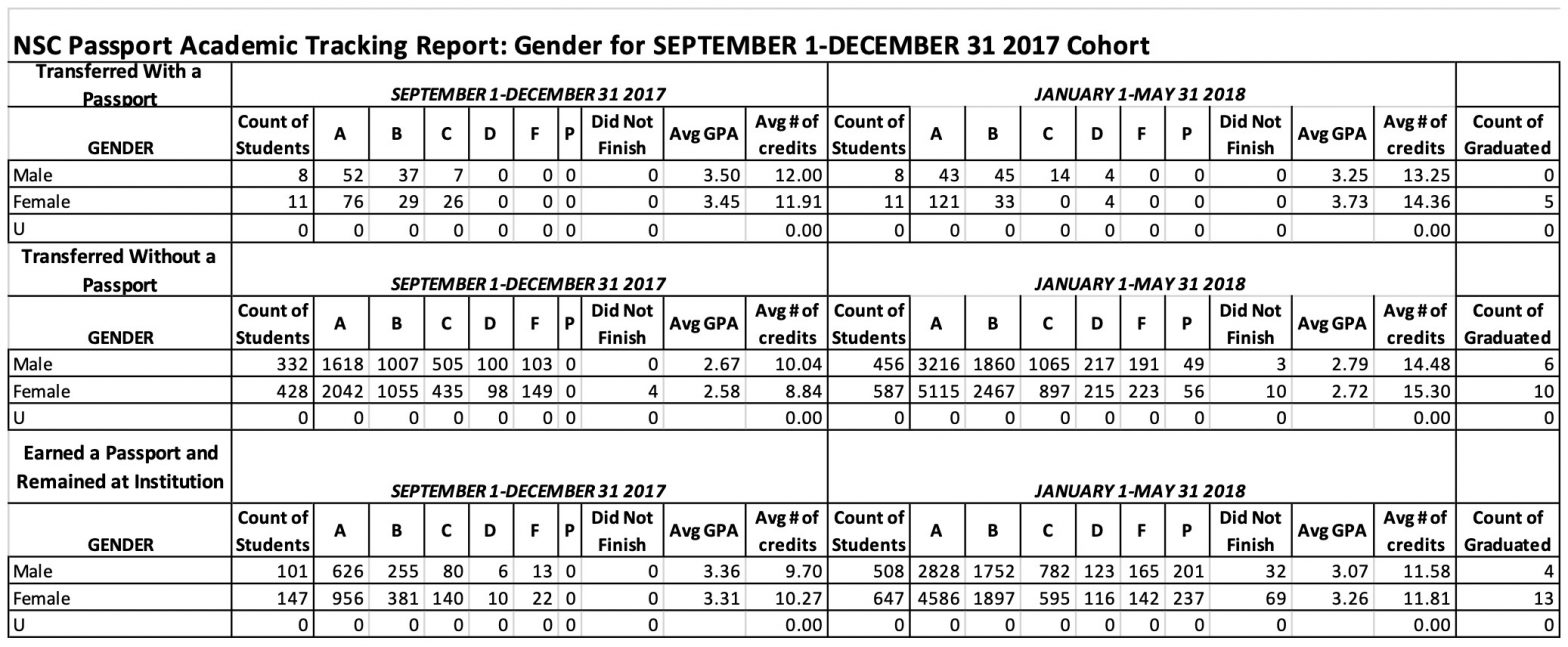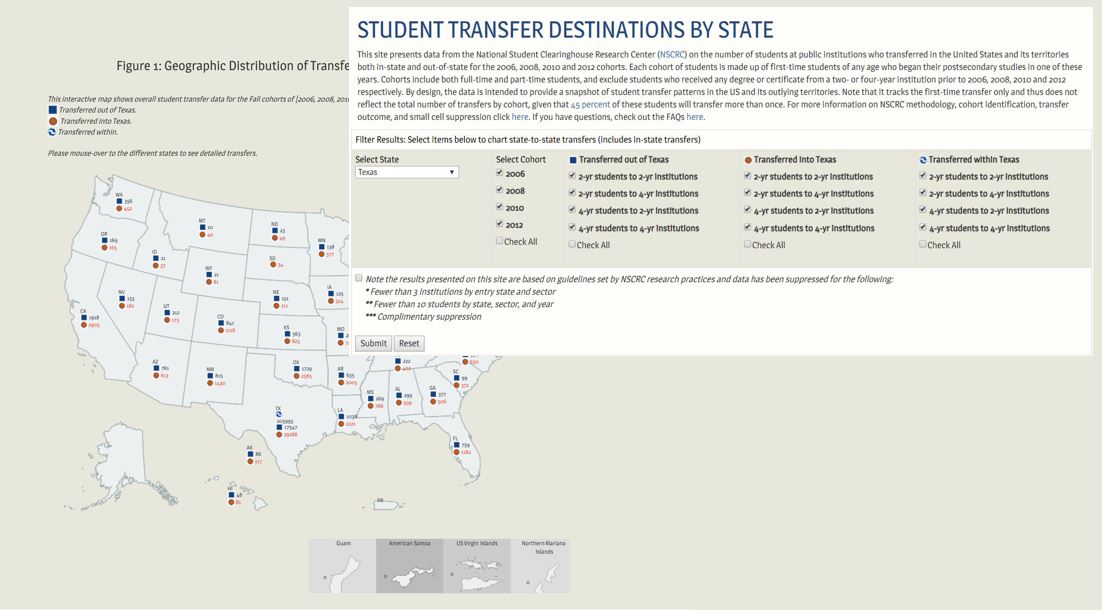
Interstate Passport Network Member Cerritos College in California works to raise awareness with its student by introducing the benefits of Interstate Passport in its newest video.


Interstate Passport Network Member Cerritos College in California works to raise awareness with its student by introducing the benefits of Interstate Passport in its newest video.

The Passport Review Board recently approved the Interstate Passport 2017-2018 Annual Report. This report provides a thorough update on the program’s accomplishments during its second year of implementation. Topics covered include the expansion of the Network, the marketing campaign and collateral, an analysis of early Academic Progress Tracking data, and future goals for the program.

On February 13, 2019 the University of Alaska Anchorage (UAA) became the thirtieth institution and the first from the state of Alaska to join the Interstate Passport Network (IPN). The IPN now spans twelve states across the country.
UAA is the largest accredited institution in the state, with urban and community campuses serving about 17,000 students. It was created in 1987 following a statewide reorganization that merged the institution with several community colleges. UAA is committed to providing instructional quality at all academic levels, helping students succeed regardless of their higher education goals, and providing service to the peoples and communities of a very large and diverse state. The mission of UAA is to discover and disseminate knowledge through teaching, research, engagement, and creative expression. Located in Anchorage and on community campuses in Southcentral Alaska, UAA is committed to serving the higher education needs of the state, its communities, and its diverse peoples. UAA is an open-access university with academic programs leading to occupational endorsements; undergraduate and graduate certificates; and associate, baccalaureate and graduate degrees in a rich, diverse and inclusive environment.
“We’re delighted to welcome University of Alaska Anchorage as a member of the Interstate Passport Network. UAA’s proximity to the Joint Base Elmendorf–Richardson is particularly beneficial to servicemen seeking to earn a Passport,” said Patricia Shea, director of academic leadership initiatives at the Western Interstate Commission for Higher Education (WICHE). “Already IPN member institutions have awarded over 25,000 Passports since the network’s launch in 2016. Students who earn a Passport and transfer to another IPN institution know in advance that their lower-division general education requirements will be met, avoiding the barriers of an outdated transfer process that sometimes leads to their dropping out. As the Interstate Passport Network grows, we expect to see more transfer students motivated to complete their degrees.”
Chancellor Cathy Sandeen commented that, “UAA is proud to be the first institution in Alaska to join the Interstate Passport. This is an important step toward greater student success. It will benefit students by allowing them to transfer to UAA without losing General Education credits, and it will benefit UAA students transferring to other IPN member institutions. Having Air University/Community College of the Airforce as a member of the Interstate Passport Network, will better serve UAA’s incoming military and veteran populations as well.”

By Michael Torrens, director of institutional research and accreditation, Utah State University
In the last two months, I’ve really discovered the value of Interstate Passport’s Academic Progress Tracking (APT). I’d like to make the case that it’s truly worth the upfront effort by participating institutions to get it programmed, to start, and to continue, reporting.
When Utah State University first embarked on developing our APT processes, there was some concern and resistance. It required dedication of some programming resources, and even once up and running, it was not that uncommon that the reporting process would require a couple of re-submissions to resolve errors created by inconsistent data in the SIS (e.g. stray spaces, punctuation, etc.). Having now had the opportunity to download our raw data from the National Student Clearinghouse (NSC) this January, however, I can confidently say that this effort was totally worth it, and I encourage all members of the Interstate Passport Network (Network) to make a renewed effort to get your process in place and start reporting as soon as possible. The more institutions that are reporting, the greater the value of the data that all of us can access.
Early in my engagement with Interstate Passport®, it was clear that part of the accountability plan for the program would include academic progress tracking of transfer students, and that there was the potential for that data to return to sending institutions. In the initial conversations among the Interstate Passport’s IR working group of representatives from institutions in seven WICHE states, there was a lot of discussion about what data would be collected and reported, and the variety of ways institutions might want to see the data. In an early meeting I recall making a list of the various dimensions and types of reports that would be greatest interest. IR folks love data and analysis! At one point I think that there were more than 15 potential dimensions of interest, and the discussion advanced to the many, many, potential cross-tabs that would be needed (e.g. combine first generation, low income by gender according to GPA earned prior to transfer). Ultimately, we narrowed the list of required dimensions down to nine (Race/Ethnicity; Gender; Age; Pell Eligible; Military Veteran; GPA Earned Before Transfer; Credits Earned Before Transfer; First Generation Student; and Degree-Level), and the discussion turned to the “static reports” that would be generated by the NSC for our institutions. I despaired.
It just didn’t seem reasonable that many dozens of reports could be produced by NSC for each member every year – and that seemed to be what would really be needed to get a full picture of the data. And then someone, I don’t remember who, had the brainstorm – why not make the full set of RAW data available for download? That possibility instantly resolved the debate about what “fixed” reports should be pushed to institutions each year. We agreed to a selection of static reports of common interest to be made available from NSC annually, but every institution would also be able to download raw data on the academic progress for their students, post-transfer, and create whatever reports they desired. What does this mean in practice? It’s the difference between this static report from NSC on a single dimension:

…and this custom report from raw data on four dimensions simultaneously:

In the graphic above, which I created from USU’s raw data file, we can clearly see that the performance of first generation, male, Pell eligible students (the ‘fat’ lines) is not as strong as that for female, first generation, Pell eligible students; and that at this institution, USU’s female, Pell eligible, first generation transfer students seem to be performing almost as well (post-transfer) as the non-first gen students.
Thus, I can’t stress how much I look forward to having data reported from all Network member institutions that have received USU’s transfer students. As a Network, we’ve reported more than 25,000 Passports awarded which is an important accomplishment in our first two years of operations. Now, we need to take the next step and report on those students’ academic progress. For Interstate Passport’s story to be accurate and robust, every member institution must report their awards and results as specified in the Memorandum of Understanding. Early results suggest that students with a Passport have post-transfer academic performance on par or better than matriculating students at the receiving institution(s), and performance that exceeds that of students transferring without a Passport, but in the absence of more APT data reported by more institutions (i.e. a larger “n”), it’s not yet enough to measure Interstate Passport’s true impact.
So, start reporting, and start downloading the raw data for your students’ post-transfer. I can say from USU’s experience, that the effort is totally worth it!

Last week, The Chronicle of Higher Education featured an article, Here’s What Trump’s Executive Order on Free Speech Says, which discusses the key items of the executive order. Interestingly, the order also requires an annual report by the U.S. Secretary of Education on successful State and institutional efforts on student transfer rates and degree completion of transfer students.
An Education Dive article, Colleges list priorities for Higher Education Act Reauthorization, examines recommendations to Congress from The Higher Education Committee of 50 Members on the Higher Education Act reauthorization which includes several recommendations regarding student transfer.
A recent report, Working as a Team for Student Success, released by the Chronicle of Higher Education discusses what institutions are doing to improve student success. One example expands on how collaborations across a college campus better serve undergraduate students including the development of faculty and staff teams that focus on transfer students.
An article, The Correlates of Credit Loss: How Demographics, Pre‑Transfer Academics, and Institutions Relate to the Loss of Credits for Vertical Transfer Students, recently published in Research in Higher Education explores how students’ pre-transfer academic characteristics, demographic characteristics, and the institutions they transferred to and from influenced the magnitude of credit loss they experienced.

Meet Robert Bullen, retired Sergeant Major for the U.S. Army Recruiting School.Currently, Bullen serves as the Veteran Outreach/Prior Learning Assessment Coordinator for University of Hawai‘i System of Community Colleges. He is the point of contact to provide informational service, outreach, and referrals for colleges wanting to establish or expand services to military personnel (active, guard and reserve), qualified military dependents, and veterans. His primary focus is promoting the Prior Learning Assessment (PLA) program by which all students can earn college credit by identifying and documenting college-level learning acquired through life experiences. This program can provide military members and veterans a connection between academic programs and their job in the military. Bullen also represents the state of Hawai‘i on the Interstate Passport Military and Veterans Affairs Advisory Committee and recently presented to attendees at the train-the-trainer workshop for military and veteran affairs advisors at Interstate Passport Network (IPN) member institutions. In his position, Bullen works to establish relations between local bases on the islands and IPN members like Leeward Community College.
Bullen states that “with such a large active duty military presence in Hawai‘i, the benefits of earning a Passport provide students the assurance that general education classes already taken will not have to be repeated again. The Interstate Passport Network (IPN) is a huge resource for military and veteran students.” Now that the Community College of the Air Force (CCAF) is an IPN member, Bullen has an office on Hickam Air Force Base, Joint Base Pearl Harbor Hickam in the Education Center. He communicates directly with Airmen about Interstate Passport and the participating IPN institutions where students with a Passport might transfer to or from.

by: Ella Butler, director of Career Services and Dr. Chuck Lepper, vice president for Student Affairs & Enrollment Management, Salt Lake Community College
As the Interstate Passport Network has grown, so too have students’ knowledge, understanding, and participation in the Interstate Passport program. Students and their families are learning how to leverage the opportunities provided by the Interstate Passport program to maximize cost savings, increase the mobility and transferability of credits already earned, and utilize earned credits to accelerate degree or certificate completion at member institutions.
As member institutions, we have also learned about the positive impact of the Interstate Passport program on the recruitment of prospective students, student perceptions about how “transfer friendly” our institutions are, as well as on student retention, persistence, and completion of certificates and degrees. Perhaps even more importantly, there is a growing recognition among the broader higher education community of the benefits of evidence-based student learning outcomes like those embedded in the Interstate Passport program. Of particular note is the developing interest in how these learning outcomes support the development of students’ cross-cutting skills that lead to employability and support for students’ future career success and advancement.
Among postsecondary educators, it is widely acknowledged that career readiness and employability skills are a critical part of the goals of higher education. Employers are seeking students who have these career competencies otherwise known as “soft skills” (NACE, 2017). Defined as having a balanced level of collegiality, technical skills, and emotional intelligence (NACE, 2017), soft skills are transferrable and applicable to most industries. Although knowledge-based or technical skills are often required to excel in a role, soft skills are considered the new standard. Being able to relate to one’s audience, work in a team, and problem solve are crucial characteristics for keeping and advancing in employment. In a recent report, the National Associations of Colleges and Employers (NACE) confirmed that employers are looking for leaders who can effectively demonstrate their ability to use soft skills. In conjunction with employers, NACE identifies these competencies as critical:
So how do students achieve these skills, and how do students gain awareness of these competencies? Hopefully, students are learning these competencies in the classroom. But unless both students and teachers know what learning outcomes they are aiming for, and can articulate the purpose of those outcomes, it is impossible to ensure that the competencies will be achieved. And, that in turn, means that students won’t be able to assure employers that they have gained the soft skills that are so important for their success in the workplace.
Among the 63 Passport Learning Outcomes of Interstate Passport are many of these important soft skill outcomes. Students who earn a Passport have documentation that acknowledges that they have achieved these PLOs at transfer-level proficiency.
With employers recognizing that a degree does not necessarily equate to advanced soft skills, career readiness skills developed through programs like Interstate Passport enable employers to better identify and focus on crucial competencies for the workplace. In addition to removing the skills gap, the Interstate Passport allows for equitable access to knowledge, skills, and experiences that empower students to live productive and fulfilling lives.

Rebekah Villafaña is currently an associate adjunct instructor, in the Sociology Department, at College of the Canyons in California. Villafaña has taught a variety of courses over the years such as Introduction to Sociology, Intimate Relationships and the Family, Introduction to Women’s Studies, Sociology of Sexualities, Introduction to Criminology, Modern Social Problems, Multiculturalism in the U.S., and Thinking Critically About Social Issues. In addition, her experience includes teaching English as a Second Language and Evidence-Based Reading Instruction for Los Angeles Unified School District for nearly 10 years. With her background and knowledge, Villafana led the Interstate Faculty Team as the chair of the Teamwork and Value Systems to develop the Passport Learning Outcomes (PLOs) and Proficiency Criteria for that area. More information on the PLOs and Proficiency Criteria can be found here. As chair, Villafaña will convene the team annually to discuss the latest developments related to teaching students the cross-cutting skills of teamwork and value systems. Villafaña also serves on the Interstate Faculty Team Chairs Committee which is convened annually and has the responsibility of making recommendations regarding the PLOs to the Passport Review Board.
Reflecting back on the development of the PLOs, Villafaña commented that “working on Interstate Passport has been a phenomenal experience. I have been able to work with colleagues across the disciplines and from a variety of states, which helped to clearly develop the Teamwork and Value Systems PLOs. During that experience, I was greatly influenced by insights from my peers in areas such as engineering, business, and communication, as we dove deeper into the relevance and significance of intentionally teaching teamwork in the classroom, as a part of 21st century learning.” Now while teaching, Villafaña states that “my classroom assignments and team projects are now designed even more purposefully by adding teamwork components such as roles, responsibilities and reflection on the teamwork process, to the assignment’s discipline specific content criterion.”

The Student Transfer Destinations by State website demonstrates transfer patterns of students across all 50 states and territories based on data secured from the National Student Clearinghouse Research Center (NSCRC). As the Interstate Passport Network has grown to a nationwide program with 30 members in 12 different states, this site has been expanded to include national transfer student data sets for the 2006, 2008, 2010, and now the 2012 cohorts. The website serves as a dynamic tool to demonstrate, over time, the transfer trends among cohorts, as well as to provide a visual display of where students are transferring to and from across state lines. In addition, a print/export feature has been added which allows viewers to print and export figures as data is viewed on the site. “We are excited to add the 2012 cohort data to the website. We can now provide viewers with snapshots of student transfer trends and patterns nationwide over a twelve year period. It is our goal, as new data becomes available from NSC for other cohorts to add it and continue to learn more about intrastate and interstate transfer over time,” said Patricia Shea, director of academic leadership initiatives at WICHE where the Interstate Passport’s operations are based.

Inside Higher Ed featured an article, Georgia Perimeter improves graduation and transfer rates after merging with Georgia State, this past month that addressed how institutions are partnering to increase graduation and transfer rates.
Learning communities can improve student transfer rates. An article, How Learning Communities Can Keep Higher Ed’s Most At-Risk Students on Track, The Chronicle of Higher Education, discusses the role of learning communities with high-risks students including improving transfer rates at insitutions.
The Community College Research Initiatives (CCRI) group focuses on the partnerships between community colleges and universities in supporting transfer student success and its critical importance in its latest report, Identifying Effective and Equitable Institutions for Transfer Students: Exploring the Contribution of the Pair in Multilevel Models.
A new study, The Benefits of Borrowing, from Education Next finds that community college students who take out student loans get better grades, earn more credits, and are more likely to transfer to four-year colleges than students who do not take out student loans.